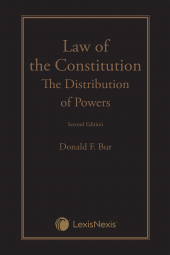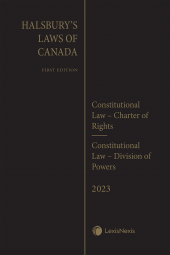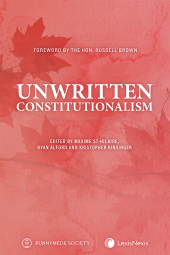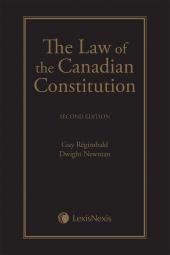Law of the Constitution: The Distribution of Powers, 2nd Edition
One Year Subscription Only Terms
Subscribers receive the product(s) listed on the Order Form and any Updates made available during the annual subscription period. Shipping and handling fees are not included in the annual price.
Subscribers are advised of the number of Updates that were made to the particular publication the prior year. The number of Updates may vary due to developments in the law and other publishing issues, but subscribers may use this as a rough estimate of future shipments. Subscribers may call Customer Support at 800-833-9844 for additional information.
Subscribers may cancel this subscription by: calling Customer Support at 800-833-9844; emailing customer.support@lexisnexis.com; or returning the invoice marked 'CANCEL'.
If subscribers cancel within 30 days after the product is ordered or received and return the product at their expense, then they will receive a full credit of the price for the annual subscription.
If subscribers cancel between 31 and 60 days after the invoice date and return the product at their expense, then they will receive a 5/6th credit of the price for the annual subscription. No credit will be given for cancellations more than 60 days after the invoice date. To receive any credit, subscriber must return all product(s) shipped during the year at their expense within the applicable cancellation period listed above.
Product description
The Constitution Act, 1867 provided this country with one of the oldest federalist constitutions in the world. Under that Constitution, legislative jurisdiction was distributed between the Canadian Parliament and the provincial legislatures through a unique system of described classes and matters that come within those classes.
Until now, the courts have developed and modified certain tests to determine the validity of legislation. As part of that process, the courts will find the matter by pithily describing the legislation at issue, and then assigning that description to one of the classes according to the developed tests. The limits of each class, then, are ultimately defined by the types of matters that have been placed within them by the courts.
There are a number of problems with this methodology. Classes are supposed to have pre-determined boundaries, and they were supposed to be exclusive. Matter was supposed to simply come within those pre-determined boundaries, but now they are placed there by the courts. And, rather than matter being simply the content of the classes, it has been replaced by pithily described legislation or legislative subjects. Instead of being exclusive, classes are now overlapping. While that overlapping of jurisdiction should be acknowledged as a failure of existing constitutional methodology, it has instead been treated as inevitable. Thus, a few versions of paramountcy have been created to deal with it — even though that concept was expressly rejected by the parties to the constitutional conferences.
There is, however, another way.
Before confederation, the province of Canada had created a de facto system of federalism, and that system formed the origins of sections 91 and 92. It is not surprising, then, that an examination of the legislation in that de facto federalism discloses, in most cases, both the limits and the content of the various distributed classes in sections 91 and 92.
It should be a simple matter to determine class limits and class content. This book does this, and then undertakes an exhaustive analysis of federalism cases decided from 1867 to 2023 to find out how the courts have interpreted sections 91 and 92. Using the origins of these two sections as a base for analyzing court decisions, it is possible to see where the courts have deviated from that original compact, and why they have done so.
Written by veteran lawyer and constitutional law expert Donald F. Bur, Law of the Constitution: The Distribution of Powers, 2nd Edition offers an insightful and thorough look at the distribution of powers in Canada between the federal and provincial governments, and provides an analysis of how the courts have treated and decided the issues that have arisen in this context.
Features of This Book
In the second edition of Law of the Constitution: The Distribution of Powers, Dr. Bur conducts a comprehensive examination of the case law related to every class within section 91 and 92 across more than 2,000 pages. His analysis of class descriptions allows readers to understand how the courts have interpreted federal and provincial legislative jurisdiction. Through the discussion of legislative matters, his analysis of the content of each class allows readers to access most of the constitutional cases that have been decided, from all levels of court, and place them within a particular class context. Moreover, by operating from the objective basis of pre-confederation federalism—the federalism that formed the origins of sections 91 and 92—it is possible to provide a critique of the approaches taken by the courts, and the decisions that they have made.
This approach enables readers not only to gain a broader understanding of what the courts have done, and what they should have done, but at the same time to conduct in-depth research in the area of constitutional law. This book also includes an in-depth discussion of the structure of the courts as well as the methodology of judicial interpretation.
What’s New In This Edition
- Updated discussion of case law since the first edition published in 2016, including:
- Supreme Court of Canada decisions in the Greenhouse Gas Pricing References; Uashaunnuat (Innu of Uashat and of Mani‐Utenam; Reference re Pan Canadian Securities Regulation; R. v. Comeau, Reference re Environmental Management Act; Rogers Communications Inc. v. Châteauguay (City); and others
- Provincial Court of Appeal decisions in the Impact Assessment Act Reference; Berger v. Saskatchewan (Financial and Consumer Affairs Authority); Travelers Insurance Company of Canada v. CAA Insurance Company; and others
- Federal Court decisions including Ouimet v. Canada; Hunt v. Canada; Elson v. Canada
- Plus important decisions from various courts of first instance
Who Should Read This Book
- Lawyers questioning the validity of legislation
- Political scientists
- Government lawyers at all levels (federal, provincial and municipal)
- Law libraries and law schools
Table of contents
Chapter I: A View of Canada
Part 1: The Constitution and Interpretive Aids
Part 2: Pre-Confederation Status of the Provinces
Part 3: Federalism
Part 4: The Agreement
Part 5: The View of Canada
Chapter II: The Courts and the Judicial System
Part 1: The Structure of the Courts
Part 2: The Methodology of Judicial Interpretation
Chapter III: The Legislative Classes
Part 1: The Federal Legislative Level
Part 2: The Provincial Legislative Level
Chapter IV: Legislative Matters
Part 1: The Federal Legislative Level
Part 2: The Provincial Legislative Level
Table of Cases
Index
 Lexis Nexis
Lexis Nexis 


